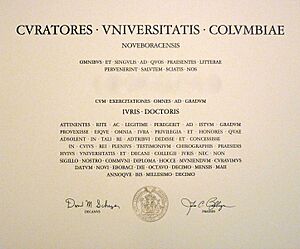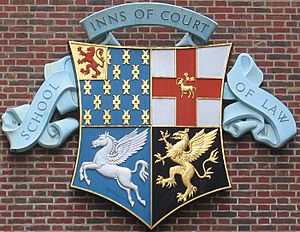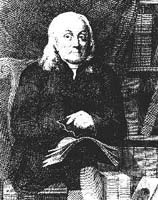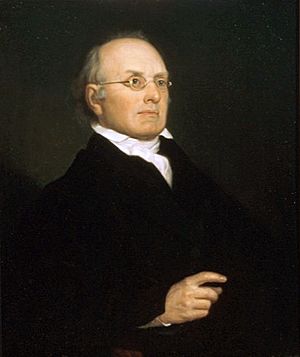Juris Doctor facts for kids
A Juris Doctor (often called JD) is a special university degree that teaches people how to become lawyers. It's like a professional degree, meaning it prepares you for a specific job. In the United States, the JD is the main degree you need to practice law. Other countries, like Australia, Canada, and Hong Kong, also have the JD. Some of these countries also offer a different law degree called an LL.B., which is usually for students who haven't finished a first university degree yet.
The JD degree started in the United States in the late 1800s. It usually takes three years of full-time study to complete. Students learn about important legal topics like how the government works (constitutional law), how court cases happen (civil procedure), and rules about crimes (criminal law). They also learn about contracts, property, and injuries (torts). After getting a JD, graduates usually need to pass a special test called a "bar examination" to get a license to practice law.
In the United States, the JD is seen as a "professional doctorate." This is different from a "research doctorate" (like a PhD), which is more about doing new research. In other places, like Australia and Hong Kong, the JD is seen as a master's degree. In Canada, it's considered a second bachelor's degree because you usually need a first degree to get into the program.
To become a licensed lawyer in most parts of the United States, you must pass a bar examination. One state, Wisconsin, is an exception. There's also a special "Patent Bar" test for lawyers who want to work with patents. For this, you need a JD and a degree in certain science fields.
Contents
What "Juris Doctor" Means
The name Juris Doctor comes from Latin. It literally means "teacher of law." Sometimes, it's also called "Doctor of Jurisprudence," which means "teacher of legal knowledge."
It's important not to mix up the JD with another degree called Legum Doctor (LLD). In some universities, especially in the United Kingdom, the LLD is a very high research degree. It means someone has made a huge contribution to law over many years. In the United States, the LLD is usually an honorary degree, given to someone to celebrate their achievements, not for studying.
How Law Degrees Started
Early Law Schools
The very first university in Europe, the University of Bologna in Italy, started as a law school in the 11th century. This school became a model for other law schools in the Middle Ages. The first university degrees might have been doctorates in civil law. These degrees showed that someone was approved to teach at universities, not necessarily to practice law.
Law Training in England
In England, universities like Cambridge and Oxford mainly taught law for philosophical reasons, not to train people to be lawyers. They taught civil and canon law, which were used in specific courts, but not the common law used in most places. To learn common law, people trained at places called the Inns of Court. Over time, the training at the Inns became less formal. People then started learning by working with individual lawyers as apprentices.
In 1292, King Edward I asked for lawyers to be trained. Students would just watch court cases. Later, they hired professionals to teach them in their homes, which led to the Inns of Court. By the 1400s, the Inns worked like universities, but they focused only on law. As more people needed lawyers, the demand for legal training grew.
Universities like Oxford and Cambridge didn't think common law was worth serious academic study. So, practical training for lawyers (called solicitors) happened through apprenticeships. In 1728, it became official that solicitors needed a five-year apprenticeship. Later, this time was shortened for university graduates.
In 1753, William Blackstone became the first person to teach English common law at the University of Oxford. He believed that law should be studied at universities, focusing on big ideas rather than just daily procedures.
By the mid-1800s, most law degrees in England were for people who already had a first degree. These degrees focused on Roman civil law, not English common law. In 1858, Cambridge started offering its LLB as an undergraduate course.
Between the 1960s and 1990s, law schools in England became more important for training lawyers. They started teaching more advanced legal topics to be more useful for the profession.
Law Training in Early America
At first, people in colonial North America didn't trust lawyers much. But slowly, colonial governments started using lawyers trained in London. After the American Revolution, each state had its own group of lawyers. Because people didn't want the legal profession to be only for the rich, the way lawyers were trained in the United States became very different from England.
Initially, lawyers in the United States were trained in England or through apprenticeships. In New York in 1730, a seven-year apprenticeship was required. Later, you needed a four-year college degree plus five years of clerking. This system was unique because England didn't require a college education for lawyers until much later.
Apprenticeships meant a lot of individual study. The experienced lawyer (mentor) was supposed to guide the student. Students would write down notes from their reading in a "commonplace book" and try to memorize them. But often, apprentices were overworked, doing boring tasks like copying documents by hand. It was also hard to find enough legal books.
Some famous lawyers, like William Livingston in 1745, said the apprenticeship system was broken. He said many mentors didn't care about their clerks' future. However, a few dedicated mentors became so popular that their offices grew into the first law schools.
Eventually, apprenticeships weren't enough to train good lawyers. The first formal law programs in U.S. universities didn't start until the late 1700s. The first law degree from a U.S. university was a Bachelor of Law (L.B.) in 1793 from the College of William and Mary. Harvard was the first to use the LLB abbreviation.
Early university law programs in the United States, like the University of Maryland School of Law (1812), included a lot of theory and philosophy. They studied works by thinkers like Cicero and Aristotle. Some said these early law schools seemed to be preparing students to be politicians rather than lawyers.
A New Way to Study Law
To compete with smaller, practical law schools, U.S. university legal education began to change. In 1826, Yale started offering a two-year "practitioners' course" with practical lessons. Joseph Story, a Supreme Court Justice, led a big change at Harvard. He pushed for a more "scientific study" of law. This meant treating law like a science, where you analyze cases to find legal principles.
This new approach combined teaching law as a science with practical skills. Today, things like "clinical training" (where students work on real cases) are a key part of legal education in the United States.
How the Juris Doctor Degree Was Created
The JD degree was created in the United States to improve how professionals were trained. Before the JD, many law students started law school right after high school or with only some college education. The LLB degree existed, but by the mid-1900s, it became a degree that almost always required a bachelor's degree first. So, it was a "bachelor's degree" in name only.
The Birth of the Juris Doctor
In the mid-1800s, people worried about the quality of legal education in the United States. Christopher Columbus Langdell, who was dean of Harvard Law School from 1870 to 1895, wanted to change things. He wanted the legal profession to be made up of university graduates, not just undergraduate students. He believed in a three-year degree after a bachelor's degree.
Langdell developed new teaching methods, like the "case method" (studying important court cases) and the "Socratic method" (asking students questions about the cases to make them think deeply). The Juris Doctor was proposed as a new, higher-level law degree that would use these methods. One reason for the change was to make all of Harvard's professional schools (theology, law, medicine, and arts) graduate schools.
The University of Chicago Law School was the first to offer the JD in 1902. At that time, only five law schools required a college degree from their applicants. Other universities like NYU, Berkeley, Michigan, and Stanford also started offering the JD. However, famous eastern law schools like Harvard and Yale didn't want to adopt the JD at first. Because of this, most law schools went back to offering the LLB as the main law degree by the 1930s.
After the 1930s, some American law schools offered both LLB and JD degrees. The JD was given to students who already had a bachelor's degree and met higher academic standards. But since the JD didn't offer any special advantages for getting a job or passing the bar, most students still chose the LLB.
In the 1950s and 1960s, more and more law students were college graduates. In 1962, the American Bar Association (ABA) suggested that all approved law schools should consider giving the JD degree as the first professional degree. By the end of the 1960s, almost all law students were required to have a bachelor's degree before starting law school. Student and alumni support helped convince even the most famous schools to switch. Columbia and Harvard changed in 1969, and Yale was the last in 1971.
Law Degrees Around the World
Legal education is different in each country because of its history and legal system. So, law degrees can vary a lot from one country to another.
| Country | How long it takes (years) |
Different courses from LL.B. in this country |
More training needed to be a licensed lawyer |
|---|---|---|---|
| Australia | 3 | No | Yes |
| Canada | 3 | No | Yes |
| Hong Kong | 2–3 | No | Yes |
| Italy | 5 | Integrated | Yes |
| Japan | 2–3 | Yes | Yes |
| Philippines | 4 | Varies | No |
| Singapore | 3 | No | Yes |
| United States | 3 | No | No, except Delaware |
Juris Doctor in Different Countries
Australia
In Australia, the traditional law degree is the undergraduate Bachelor of Laws (LLB). But since the 2010s, many Australian universities now offer JD programs. Some universities, like the University of Melbourne, have even replaced their LLB programs with the JD.
An Australian Juris Doctor usually takes three years of full-time study. All JD programs must teach certain required subjects. JDs are seen as similar to LLBs, and graduates need to meet the same requirements to become lawyers, including practical training. In Australia, the JD is called a "masters degree (extended)," and people with a JD cannot use the title "doctor."
Canada
The JD degree is the main law degree in Canada for common law. It has replaced many of the old LLB programs. In Canada, the LLB was usually a second degree, meaning you needed another university degree first. The University of Toronto Faculty of Law was the first to rename its law degree to JD in 2001.
To get into a JD program in Canada, you usually need at least two or three years of study towards a bachelor's degree. Almost all successful applicants have already finished a bachelor's degree. The JD in Canada is considered a bachelor's degree.
Canadian JD programs are three years long. The first year has required courses like public law, property law, and criminal law. After that, students can choose elective courses in areas like business law or international law. After graduating, you need to pass a bar exam and complete a period of supervised training before you can practice law.
Some law schools in Canada and the United States offer joint programs. This allows students to get both a Canadian and an American JD degree.
Hong Kong
The JD degree is offered at several universities in Hong Kong. It's very similar to the LLB there, but it's for students who already have a degree in a non-law subject. The JD in Hong Kong usually takes two to three years. It's considered a master's degree.
In Hong Kong, neither the LLB nor the JD is enough to get a license to practice law. Graduates of both degrees also need to take another course called the Postgraduate Certificate in Laws (PCLL) and then do a training period.
Italy
In Italy, the main degree for legal professions like lawyers or judges is the Laurea Magistrale in Giurisprudenza. Legal studies have a long history in Italy, with the University of Bologna being a major center for law studies centuries ago.
This Italian law degree is a five-year program that you can enter after high school. It includes classes in legal theory and subjects, but not practical training. It ends with a thesis. This degree is considered a master's-level degree. Graduates are called "Doctor of Law" (Dottore in legge).
After getting this degree, you can register with a bar association. Then you need to do an 18-month apprenticeship with a practicing lawyer before taking the bar exam.
Japan
In Japan, the JD is called Homu Hakushi. The program usually lasts three years. There are also two-year JD programs for people who already have some legal knowledge, like those with an undergraduate law degree. This degree focuses on professional training, but it's not enough to get a license to practice law in Japan. After passing the bar exam, all candidates need to do 12 months of practical training. In Japan, the JD is a "professional degree," which is different from academic master's or research doctorate degrees.
Philippines
In the Philippines, the JD exists alongside the more common undergraduate LLB. Like the LLB, it takes four years of study. The JD includes core law subjects, an apprenticeship, and a thesis.
The Ateneo Law School was the first to offer the JD in the Philippines. In 2008, the University of the Philippines College of Law started giving the JD to its graduates, changing its LLB program to JD. Other universities have also made this change.
Singapore
The JD degree is offered at all three law schools in Singapore, which also offer LLB degrees. It is a degree that qualifies you to become a lawyer in Singapore. If you graduate from these programs, you are considered a "qualified person" and can be admitted to the Singapore Bar.
JD in Academia
In the United States, the Juris Doctor is the degree that prepares someone to become a lawyer. It's similar to how an MD prepares someone to be a doctor. While the JD is the only degree needed to become a law professor or practice law, it's not considered a "research degree" like a PhD.
Research degrees in law include the Master of Laws (LL.M.), which usually requires a JD first, and the Doctor of Juridical Science (S.J.D./J.S.D.), which usually requires an LL.M. first.
However, the American Bar Association (ABA) has stated that the JD and the PhD should be considered equal for job purposes in education. This is because a JD requires a lot of study (84 to 90 semester hours) compared to a PhD (usually 60 semester hours plus a dissertation).
So, most law professors have a JD as their highest degree and can teach and supervise students getting LL.M. and J.S.D. degrees. But more and more, law schools are hiring professors who have both a JD and a PhD.
The United States Department of Education classifies the JD as a "doctor's degree – professional practice." It classifies the PhD as a "doctor's degree – research/scholarship."
Using the Title "Doctor"
In the United States, it's generally not common to call someone with a JD degree "doctor."
In the late 1960s, as more American law schools started giving out JDs, there was a debate about whether lawyers could use the title "doctor." At first, ethics rules said no, unless you were dealing with countries where lawyers commonly used the title. But later, the rules changed to allow it in academic settings if the university considered the JD a doctor's degree.
The rules continued to be debated and changed. While many state bar associations now allow the use of the title, some prohibit it if it might confuse the public into thinking a lawyer is a medical doctor. For example, The Wall Street Journal newspaper specifically says that lawyers are not called "doctor."
Images for kids
See also
 In Spanish: Juris doctor para niños
In Spanish: Juris doctor para niños






